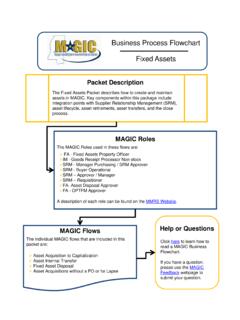Transcription of THE STRATEGIC PLANNING PROCESS - Cru
1 THE STRATEGICPLANNING PROCESSSome leaders seem to do very little formal PLANNING yet they accomplish incredible things. They have a clear picture of what they want to accomplish and do an excellent job of bringing and keeping people on board toward its fulfillment. People are aligned around the vision. These leaders make wise decisions in view of the objective, much in the same way that the captain of a sailing vessel works with his environment to go from destination to destination. In reality these people are STRATEGIC thinkers and planners usingthe STRATEGIC PLANNING IS THE STRATEGIC PLANNING PROCESS ?Committing ourselves to the PLANNING PROCESS is different than committing ourselves to a plan.
2 Many plans are simply filed away because of theirobsolescence after the first month or so. The plan failed, not because we failed to plan but we failed to plan in accordance with our changing STRATEGIC PLANNING PROCESS is needed anytime we are operating from a changing, unpredictable environment where we are expected to accomplish something great with limited resources. These are the conditions of the changing environment of the university campus and student culture. The rate of change is rapid and unpredictable. Our financial andhuman resources are scarce. We can not afford to stick with plans that don t work or are filled out simply to satisfy an administrative requirement. We don t need a plan as much as we need to master a PLANNING PROCESS .
3 BENEFITS OF STRATEGIC PLANNING PROCESSAn important advantage of the STRATEGIC PLANNING PROCESS is that it involves all stakeholders, is highly visual and it can be done quickly. The key of the PLANNING session is that it forces all the participants to focus on what will have a real STRATEGIC impact on the movement. This PROCESS helps the team to visually conceptualize the key issues and to allow them to focus on those factors that are critical to accomplishing the your STRATEGIC plan--a visual map Although this diagram suggests sequential and linear PLANNING with a beginning and an end, in reality it is a fluid, ongoing PROCESS that is continually being refined to take us closer to the fulfillment of our mission.
4 This PROCESS is really linear only once--the first time youuse it. After that it is dynamic and really doesn t matter where you start or finish as long asyou touch all the bases. The local leader ought to be working through this PROCESS in his/ her heart and head several times a day and as a team several times a quarter. It s more than a planningprocess, it s a way of looking at life and ministry opportunities.#1 DIRECTION WHERE WE ARE GOING?The first step of the STRATEGIC PLANNING PROCESS is to clearly articulate our direction. The components of direction are purpose, values, mission and vision. Purpose serves as the north star. It can be general, sweeping and vague, but at least it tells you that you THE STRATEGIC PLANNING PROCESS 1 2010, CruPress, All Rights Reserved.
5 Going north and not east or south. It tells us what business we are in. Our purpose centers aroundglorifying God by helping to fulfill the Great Commission. Mission flows from purpose and is the road sign that answers the question, What will we do for whom? This needs to be answered with painful specificity to be useful. It says we are going to Minneapolis, not Seattle or Saskatoon. Vision flows from purpose and mission. It is the emotive, artful, Monet part of our direction. While purpose and mission are static, vision is dynamic, in constant interaction with the present situation, opportunities, realities, values and aspirations of the than informing others what we want or see, spiritual vision originates from the heart of God.
6 It comes from asking, Lord, what great thing do you want done that we can get in on? A good corporate vision encompasses, not stiffles, the individual visions of those who will work to fulfill and vision casting is required to pull this off. Remember, vision, no matter how grand, is still subject to purpose and mission. In other words, in the US, a vision for a soup kitchen may fit under our purpose to glorify God but not under our mission of turning lost students into Christ-centered laborers. To summarize: Purpose--what we live for Values--what we stand for Mission--what we shoot for Vision--what we root forThe direction setting step should accomplish two things for the leadership and those they are leading.
7 It should communicate 1) hope--our best years are ahead of us and 2) vital necessity--these are the few things we are going to take personal and public responsibility for. By the time you are done, you should have communicated the direction in an emotionally compelling (vision) and intellectually credible (mission) manner. The PROCESS of alignmentshould have begun. It s part Monet (vague) and part Rockwell (clear and specific). For this reason, it is often beneficial to quantify the vision through specific time-bound goals.#2 SITUATIONAL ANALYSIS--FACING REALITYThe second step in the STRATEGIC PLANNING PROCESS is to get all the facts we can about our present situation. Here we consider the strengths (assets) and weaknesses (liabilities) of our external environment and internal (ministry) situation.
8 You can never align people to a vision of the future unless they agree with your perception of the present.#3 CRITICAL MASS LEADERS AND TOOLSThe third step is to define with clarity and precision the key components critical to get started--to get you launched in your mission. To define critical mass is to define how much of what it will take to get you started (continue and eventually fulfill your mission). Your initial critical mass must be sufficient to: Break gravity--get the thing off the to get you launched. Ensure at least two wins along your critical path. Without a couple of initial wins, you will not have the momentum to sustain your critical path. Generate the capacity to build the resource base required to fulfill your vision You don t need all of your resources in place to begin accomplishing the mission, but you do need critical mass to take the first step.
9 You don t need to persuade every person or even half of those involved. You need to target those 15% of early adapters who will lead the middle and late adapters. The laggards may never come on board, but that s OK. When Moses used this PROCESS , he knew that his mission was to lead the Israelites out of Egypt. His critical mass was to simply convince the elders (Exodus 3:16, 4:29). He had to have the leaders on board before trying to convince the people (6:9) and Pharaoh (7:1-6). He didn t need a plan at that time to cross the Red Sea or provide food and water for the multitude--God would provide that later. But he did need enough to determining your critical mass you are asking and answering, What do we need to launch?
10 Perhaps it is as simple as $50 and five students. One successful entrepreneur defined critical mass as simply a vision and people to share it with. He understood that ifthe vision was powerful and compelling enough and he had the right audience to share it with, the vision would act as a powerful magnet and attract the right leaders and resources to achieve it. Is your vision compelling?THE STRATEGIC PLANNING PROCESS 2 2010, CruPress, All Rights Reserved. #4 CRITICAL PATHThe fourth step in the STRATEGIC PLANNING PROCESS is to determine your critical path. That is, to determine the absolute and essential things we must do to move us toward the vision and mission without which the mission and vision cannot be fulfilled.











